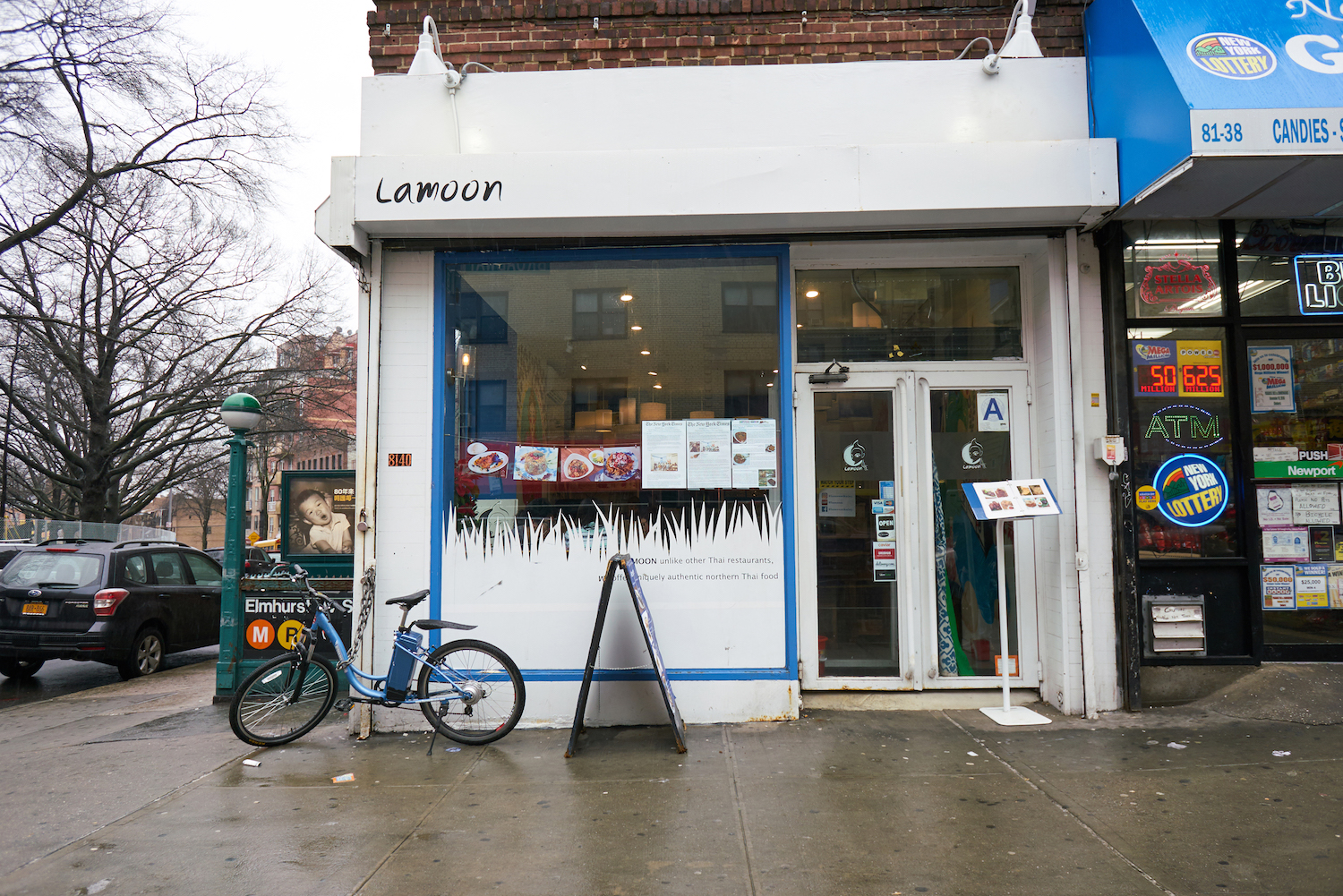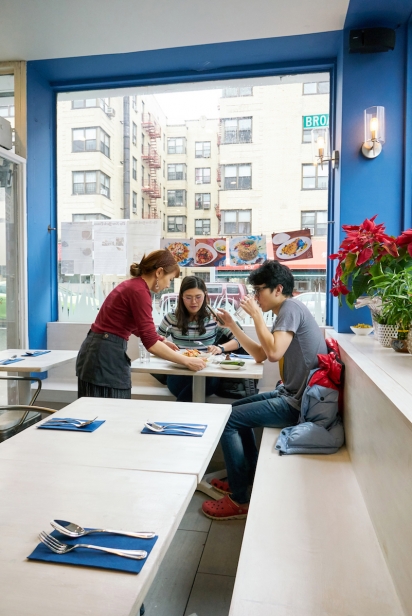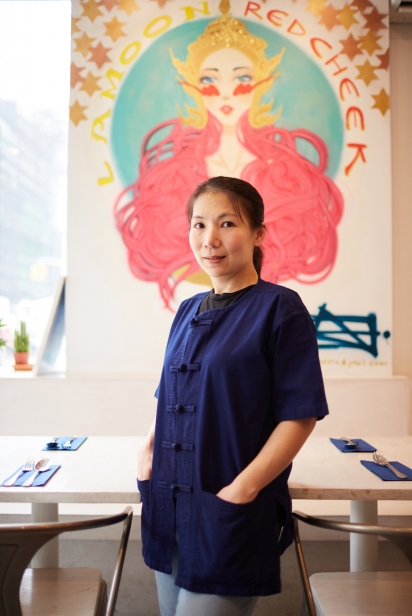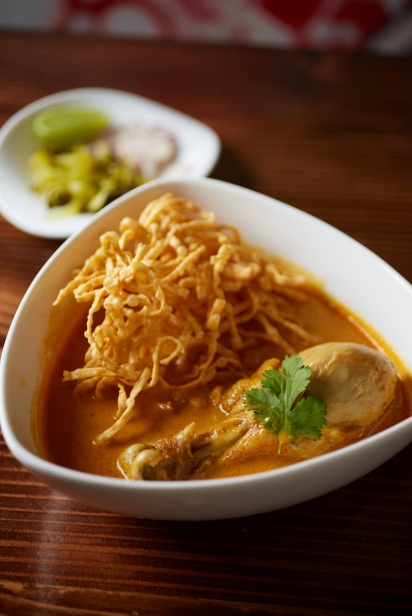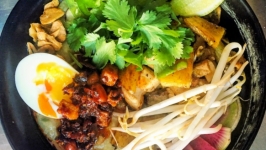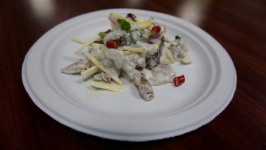Lamoon Thai Lights Up Elmhurst: Arada Moonroj cooks the northern Thai food of her youth
When Arada Moonroj was a child, the only foods her family bought at the store were salt and fish sauce. Her aunt and uncle grew rice, they picked fruits from the jungle, vegetables and herbs were picked from the backyard garden and meat—mostly pork—was raised locally. Fish were caught by net in local rivers.
After Moonroj’s mother moved to faraway Bangkok for work (the distance between her village and the capital is as far as Ohio from New York), her grandmother taught her how to cook, starting with rice, then various chili pastes and finally complete dishes. They cooked over a wood-burning stove in clay pots and never used measuring cups. Moonroj learned how to identify the staple ingredients of Northern Thai cooking through trips to the garden, where she would cut stalks of lemongrass and galangal.
Nearly 30 years later, Moonroj has begun writing her recipes in Thai on the back of receipts. She’s had to do this so her staff at Lamoon, her Elmhurst restaurant, can re-create the dishes of her childhood—jackfruit salad, ground pork salad and khao soi (curried noodle soup)— for the growing stream of customers.
In 2008, Moonroj came to the United States on a year-long exchange; she worked for and lived with an Italian family in Long Island. Thai food and ingredients were scarce, but she made noodle soup for the family once a week and the grandmother taught her about Italian cuisine. Years later, thinking of artichokes makes her smile. Aside from the lack of Thai cuisine, Moonroj enjoyed living in New York, so she returned to Thailand and got a student visa. This time, she studied English and lived in Elmhurst’s Little Thailand, where she knew she could find Thai groceries (this brought her to tears).
She called a college friend in the area with whom she’d studied in Bangkok but fallen out of touch with. They met up—now he’s her husband. While studying English, Moonroj continued nannying, and began catering events for friends and the families she worked for. The reaction was overwhelmingly positive.
Eventually, Moonroj and her husband decided to open a restaurant: Lamoon Thai. It was a chance to make the tastes of home a permanent part of Moonroj’s new life in Queens. In addition to the restaurant, they have two children; the younger was born two months before Lamoon opened, in March 2018. Living just blocks from the restaurant allowed Moonroj to run home to feed her children and pump milk, returning to work after they fell asleep.
Moonroj’s husband once worked in one of the city’s many Thai restaurants. But the trouble with the food at these places, in Moonroj’s view, is that “it’s too harsh. It hits you over the head.” Her food, which she calls delicate, builds flavor slowly. The creaminess of the curry for khao soi—one of Northern Thailand’s most famous dishes—comes from blended caramelized onions and a bit of coconut sugar, not just the commonly used coconut milk. It’s the “home taste” of the recipes Moonroj learned from her grandma, what she couldn’t find elsewhere.
After the couple opened Lamoon, people kept asking: Do you serve pad thai? At first they didn’t, but customers were hungry for it. Moonroj acknowledged the commercial realities of running a restaurant: She’d studied business in college, after all. They added pad thai to the menu three months after opening. It’s a twist on the typical rendition—she steeps the noodles in Thai iced tea before cooking. It’s one of the few dishes not inspired by her grandmother: She learned this recipe through YouTube videos from Southern Thailand.
Lamoon has deeply personal roots; Moonroj’s story is woven throughout the entire space. She had friends from Bangkok come to paint the walls blue, inlaid with a boombox-toting character called Red Cheek, who also moved from Thailand to New York. The blue hanging lamps are inspired by the lamps released in the air on a Thai thanksgiving holiday. Even Lamoon is a play on her surname, Moonroj points out. Her touch is everywhere, even in simple garnishes.
She took a several-hour fruit carving course while living in Bangkok, and finds it a relaxing way to unwind, carving pumpkins and melons in her living room as she struggles to sit still. To garnish a salad, she’ll turn a carrot into a leaf and a tomato into a petal.
As Moonroj moves around Lamoon’s kitchen, she juggles canisters of spices and other homegrown ingredients. Kaffir lime rind is a key ingredient in many of the dishes, but it’s expensive here. Moonroj’s solution is ingenious: Her mother has a kaffir lime tree in her backyard in Thailand. Every year, she spends a few months in New York City visiting her grandchildren, so she dries the lime peels in the shade (because sun kills the flavor) and packs them in her suitcase.
For some of Lamoon’s dishes, like the mango salad—an after-school snack Moonroj grew up with—it’s a bit easier to source ingredients locally, though ripeness can be an issue. Now, she often prepares it for her children, and finds it supremely refreshing any time of day. The dressing is based on a combination of coconut sugar and fish sauce cooked down to form a loose, salty caramel that’s mixed with fresh lime juice. When Moonroj’s daughter returns from her bilingual English-Mandarin school, she’s lucky to find this waiting for her. Lamoon’s lunch and dinner guests are grateful to have this taste of Moonroj’s home waiting for them as well.


